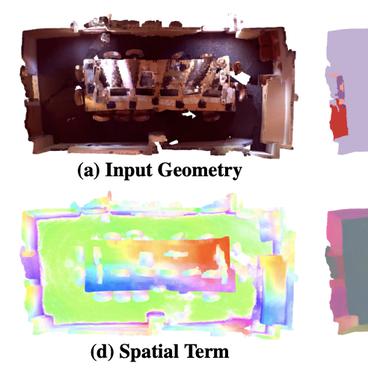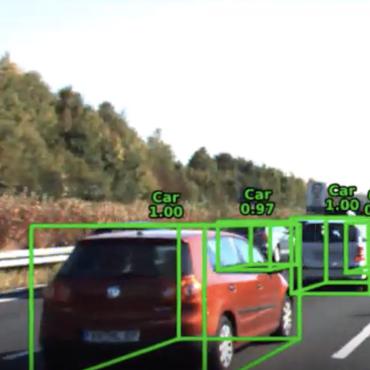Search Results for author: Alexander Hermans
Found 22 papers, 15 papers with code
An Ordinal Regression Framework for a Deep Learning Based Severity Assessment for Chest Radiographs
1 code implementation • 8 Feb 2024 • Patrick Wienholt, Alexander Hermans, Firas Khader, Behrus Puladi, Bastian Leibe, Christiane Kuhl, Sven Nebelung, Daniel Truhn
This study investigates the application of ordinal regression methods for categorizing disease severity in chest radiographs.
Cyto R-CNN and CytoNuke Dataset: Towards reliable whole-cell segmentation in bright-field histological images
1 code implementation • 28 Jan 2024 • Johannes Raufeisen, Kunpeng Xie, Fabian Hörst, Till Braunschweig, Jianning Li, Jens Kleesiek, Rainer Röhrig, Jan Egger, Bastian Leibe, Frank Hölzle, Alexander Hermans, Behrus Puladi
Utilizing this dataset, we compared the performance of Cyto R-CNN to other popular cell segmentation algorithms, including QuPath's built-in algorithm, StarDist and Cellpose.
UGainS: Uncertainty Guided Anomaly Instance Segmentation
no code implementations • 3 Aug 2023 • Alexey Nekrasov, Alexander Hermans, Lars Kuhnert, Bastian Leibe
Our approach centers on an out-of-distribution segmentation model for identifying uncertain regions and a strong generalist segmentation model for anomaly instances segmentation.
DynaMITe: Dynamic Query Bootstrapping for Multi-object Interactive Segmentation Transformer
no code implementations • ICCV 2023 • Amit Kumar Rana, Sabarinath Mahadevan, Alexander Hermans, Bastian Leibe
We introduce a more efficient approach, called DynaMITe, in which we represent user interactions as spatio-temporal queries to a Transformer decoder with a potential to segment multiple object instances in a single iteration.
Point2Vec for Self-Supervised Representation Learning on Point Clouds
1 code implementation • 29 Mar 2023 • Karim Abou Zeid, Jonas Schult, Alexander Hermans, Bastian Leibe
Recently, the self-supervised learning framework data2vec has shown inspiring performance for various modalities using a masked student-teacher approach.
 Ranked #3 on
Few-Shot 3D Point Cloud Classification
on ModelNet40 10-way (20-shot)
(using extra training data)
Ranked #3 on
Few-Shot 3D Point Cloud Classification
on ModelNet40 10-way (20-shot)
(using extra training data)
 3D Part Segmentation
3D Part Segmentation
 Few-Shot 3D Point Cloud Classification
+3
Few-Shot 3D Point Cloud Classification
+3
TarViS: A Unified Approach for Target-based Video Segmentation
1 code implementation • CVPR 2023 • Ali Athar, Alexander Hermans, Jonathon Luiten, Deva Ramanan, Bastian Leibe
A single TarViS model can be trained jointly on a collection of datasets spanning different tasks, and can hot-swap between tasks during inference without any task-specific retraining.
 Ranked #2 on
Video Panoptic Segmentation
on KITTI-STEP
(using extra training data)
Ranked #2 on
Video Panoptic Segmentation
on KITTI-STEP
(using extra training data)
Learning 3D Human Pose Estimation from Dozens of Datasets using a Geometry-Aware Autoencoder to Bridge Between Skeleton Formats
1 code implementation • 29 Dec 2022 • István Sárándi, Alexander Hermans, Bastian Leibe
Our approach scales to an extreme multi-dataset regime, where we use 28 3D human pose datasets to supervise one model, which outperforms prior work on a range of benchmarks, including the challenging 3D Poses in the Wild (3DPW) dataset.
Mask3D: Mask Transformer for 3D Semantic Instance Segmentation
1 code implementation • 6 Oct 2022 • Jonas Schult, Francis Engelmann, Alexander Hermans, Or Litany, Siyu Tang, Bastian Leibe
Modern 3D semantic instance segmentation approaches predominantly rely on specialized voting mechanisms followed by carefully designed geometric clustering techniques.
 Ranked #1 on
3D Instance Segmentation
on STPLS3D
Ranked #1 on
3D Instance Segmentation
on STPLS3D
 3D Instance Segmentation
3D Instance Segmentation
 3D Semantic Instance Segmentation
+1
3D Semantic Instance Segmentation
+1
Global Hierarchical Attention for 3D Point Cloud Analysis
no code implementations • 7 Aug 2022 • Dan Jia, Alexander Hermans, Bastian Leibe
For the 3D object detection task, GHA improves the CenterPoint baseline by +0. 5% mAP on the nuScenes dataset, and the 3DETR baseline by +2. 1% mAP25 and +1. 5% mAP50 on ScanNet.
Differentiable Soft-Masked Attention
1 code implementation • 1 Jun 2022 • Ali Athar, Jonathon Luiten, Alexander Hermans, Deva Ramanan, Bastian Leibe
Recently, "Masked Attention" was proposed in which a given object representation only attends to those image pixel features for which the segmentation mask of that object is active.
HODOR: High-level Object Descriptors for Object Re-segmentation in Video Learned from Static Images
1 code implementation • CVPR 2022 • Ali Athar, Jonathon Luiten, Alexander Hermans, Deva Ramanan, Bastian Leibe
Existing state-of-the-art methods for Video Object Segmentation (VOS) learn low-level pixel-to-pixel correspondences between frames to propagate object masks across video.
2D vs. 3D LiDAR-based Person Detection on Mobile Robots
no code implementations • 21 Jun 2021 • Dan Jia, Alexander Hermans, Bastian Leibe
Person detection is a crucial task for mobile robots navigating in human-populated environments.
Self-Supervised Person Detection in 2D Range Data using a Calibrated Camera
1 code implementation • 16 Dec 2020 • Dan Jia, Mats Steinweg, Alexander Hermans, Bastian Leibe
Through experiments on the JackRabbot dataset with two detector models, DROW3 and DR-SPAAM, we show that self-supervised detectors, trained or fine-tuned with pseudo-labels, outperform detectors trained only on a different dataset.
DR-SPAAM: A Spatial-Attention and Auto-regressive Model for Person Detection in 2D Range Data
2 code implementations • 29 Apr 2020 • Dan Jia, Alexander Hermans, Bastian Leibe
Detecting persons using a 2D LiDAR is a challenging task due to the low information content of 2D range data.
Visual Person Understanding through Multi-Task and Multi-Dataset Learning
no code implementations • 7 Jun 2019 • Kilian Pfeiffer, Alexander Hermans, István Sárándi, Mark Weber, Bastian Leibe
We address the problem of learning a single model for person re-identification, attribute classification, body part segmentation, and pose estimation.
Deep Person Detection in 2D Range Data
1 code implementation • 6 Apr 2018 • Lucas Beyer, Alexander Hermans, Timm Linder, Kai O. Arras, Bastian Leibe
Detecting humans is a key skill for mobile robots and intelligent vehicles in a large variety of applications.
Exploring Spatial Context for 3D Semantic Segmentation of Point Clouds
1 code implementation • 5 Feb 2018 • Francis Engelmann, Theodora Kontogianni, Alexander Hermans, Bastian Leibe
The recently proposed PointNet architecture presents an interesting step ahead in that it can operate on unstructured point clouds, achieving encouraging segmentation results.
MaskLab: Instance Segmentation by Refining Object Detection with Semantic and Direction Features
no code implementations • CVPR 2018 • Liang-Chieh Chen, Alexander Hermans, George Papandreou, Florian Schroff, Peng Wang, Hartwig Adam
Within each region of interest, MaskLab performs foreground/background segmentation by combining semantic and direction prediction.
 Ranked #85 on
Instance Segmentation
on COCO test-dev
(using extra training data)
Ranked #85 on
Instance Segmentation
on COCO test-dev
(using extra training data)
In Defense of the Triplet Loss for Person Re-Identification
31 code implementations • 22 Mar 2017 • Alexander Hermans, Lucas Beyer, Bastian Leibe
In the past few years, the field of computer vision has gone through a revolution fueled mainly by the advent of large datasets and the adoption of deep convolutional neural networks for end-to-end learning.
 Ranked #3 on
Person Re-Identification
on CUHK03
(Rank-5 metric)
Ranked #3 on
Person Re-Identification
on CUHK03
(Rank-5 metric)
Superpixels: An Evaluation of the State-of-the-Art
2 code implementations • 6 Dec 2016 • David Stutz, Alexander Hermans, Bastian Leibe
As such, and due to their quick adoption in a wide range of applications, appropriate benchmarks are crucial for algorithm selection and comparison.
Full-Resolution Residual Networks for Semantic Segmentation in Street Scenes
4 code implementations • CVPR 2017 • Tobias Pohlen, Alexander Hermans, Markus Mathias, Bastian Leibe
Therefore, additional processing steps have to be performed in order to obtain pixel-accurate segmentation masks at the full image resolution.
 Ranked #25 on
Real-Time Semantic Segmentation
on Cityscapes test
Ranked #25 on
Real-Time Semantic Segmentation
on Cityscapes test
DROW: Real-Time Deep Learning based Wheelchair Detection in 2D Range Data
no code implementations • 8 Mar 2016 • Lucas Beyer, Alexander Hermans, Bastian Leibe
We propose a Convolutional Neural Network (CNN) based detector for this task.








